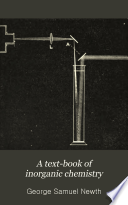 | Charles B. Bender - 1885 - 242 pages
...true theory are by no means in conflict. The theoretical quantity of material required for a structure is proportional to the sum of the products obtained by multiplying the maximum strain of each member with its length. This sum we shall term "strain-length," and we denote... | |
 | Lothar Meyer - 1892 - 260 pages
...energy we understand half the product of the mass into the square of the velocity. The pressure of the is proportional to the sum of the products obtained by multiplying the mass of each individual particle by half the . square of its velocity. And as, according to Gay Lussac's... | |
 | George S. Newth - 1895 - 696 pages
...the bombardment of its molecules against the containing vessel; in other words, the pressure of a gas is proportional to the sum of the products obtained by multiplying the mass of each molecule by half the square of its velocity. It will be obvious that if the space within... | |
 | George Samuel Newth - 1900 - 700 pages
...bombardment of its molecules against the containing vessel ; in other words, the pressure of a gas is proportional to the sum of the products obtained by multiplying the mass of each molecule by half the square of its velocity. It will be obvious that if the space within... | |
 | George Samuel Newth - 1902 - 764 pages
...bombardment of its molecules against the containing vessel ; in other words, the pressure of a gas is proportional to the sum of the products obtained by multiplying the mass of each molecule by half the square of its velocity. It will be obvious that if the space within... | |
 | George S. Newth - 1905 - 754 pages
...bombardment of its molecules against the containing vessel ; in other words, the pressure of a gas is proportional to the sum of the products obtained by multiplying the mass of each molecule by half the square of its velocity. It will be obvious that if the space within... | |
 | R. Howard Duncan - 1910 - 156 pages
...strip, and the area of the whole figure is equal to the sum of the areas of the several strips, that is, to the sum of the products obtained by multiplying the length of each mid-ordinate by the width of one strip, or to the product of the mean of the mid-ordinates and the... | |
 | George S. Newth - 1912 - 822 pages
...the bombardment of its molecules against the containing vessel; in other words, the pressure of a gas is proportional to the sum of the products obtained by multiplying the mass of each molecule by half the square of its velocity. It will be obvious that if the space within... | |
 | Cyril Methodius Jansky - 1917 - 444 pages
...If both the electromotive force and current waves contain upper harmonics, then the resultant torque is proportional to the sum of the products obtained by multiplying the effective value of each electromotive force harmonic by the effective value of the current harmonic... | |
| |